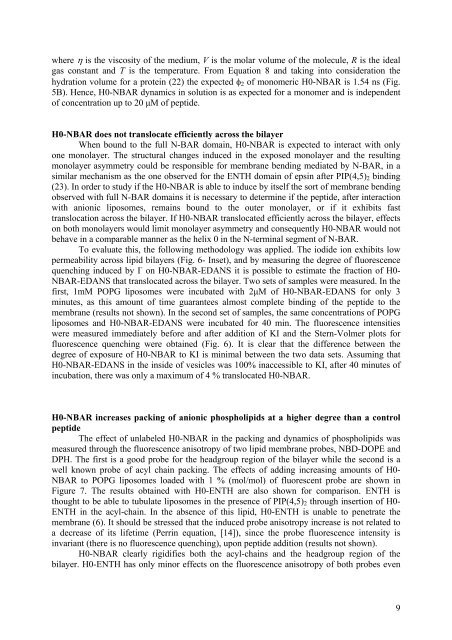Biophysical studies of membrane proteins/peptides. Interaction with ...
Biophysical studies of membrane proteins/peptides. Interaction with ...
Biophysical studies of membrane proteins/peptides. Interaction with ...
Create successful ePaper yourself
Turn your PDF publications into a flip-book with our unique Google optimized e-Paper software.
where η is the viscosity <strong>of</strong> the medium, V is the molar volume <strong>of</strong> the molecule, R is the ideal<br />
gas constant and T is the temperature. From Equation 8 and taking into consideration the<br />
hydration volume for a protein (22) the expected φ 2 <strong>of</strong> monomeric H0-NBAR is 1.54 ns (Fig.<br />
5B). Hence, H0-NBAR dynamics in solution is as expected for a monomer and is independent<br />
<strong>of</strong> concentration up to 20 μM <strong>of</strong> peptide.<br />
H0-NBAR does not translocate efficiently across the bilayer<br />
When bound to the full N-BAR domain, H0-NBAR is expected to interact <strong>with</strong> only<br />
one monolayer. The structural changes induced in the exposed monolayer and the resulting<br />
monolayer asymmetry could be responsible for <strong>membrane</strong> bending mediated by N-BAR, in a<br />
similar mechanism as the one observed for the ENTH domain <strong>of</strong> epsin after PIP(4,5) 2 binding<br />
(23). In order to study if the H0-NBAR is able to induce by itself the sort <strong>of</strong> <strong>membrane</strong> bending<br />
observed <strong>with</strong> full N-BAR domains it is necessary to determine if the peptide, after interaction<br />
<strong>with</strong> anionic liposomes, remains bound to the outer monolayer, or if it exhibits fast<br />
translocation across the bilayer. If H0-NBAR translocated efficiently across the bilayer, effects<br />
on both monolayers would limit monolayer asymmetry and consequently H0-NBAR would not<br />
behave in a comparable manner as the helix 0 in the N-terminal segment <strong>of</strong> N-BAR.<br />
To evaluate this, the following methodology was applied. The iodide ion exhibits low<br />
permeability across lipid bilayers (Fig. 6- Inset), and by measuring the degree <strong>of</strong> fluorescence<br />
quenching induced by I - on H0-NBAR-EDANS it is possible to estimate the fraction <strong>of</strong> H0-<br />
NBAR-EDANS that translocated across the bilayer. Two sets <strong>of</strong> samples were measured. In the<br />
first, 1mM POPG liposomes were incubated <strong>with</strong> 2μM <strong>of</strong> H0-NBAR-EDANS for only 3<br />
minutes, as this amount <strong>of</strong> time guarantees almost complete binding <strong>of</strong> the peptide to the<br />
<strong>membrane</strong> (results not shown). In the second set <strong>of</strong> samples, the same concentrations <strong>of</strong> POPG<br />
liposomes and H0-NBAR-EDANS were incubated for 40 min. The fluorescence intensities<br />
were measured immediately before and after addition <strong>of</strong> KI and the Stern-Volmer plots for<br />
fluorescence quenching were obtained (Fig. 6). It is clear that the difference between the<br />
degree <strong>of</strong> exposure <strong>of</strong> H0-NBAR to KI is minimal between the two data sets. Assuming that<br />
H0-NBAR-EDANS in the inside <strong>of</strong> vesicles was 100% inaccessible to KI, after 40 minutes <strong>of</strong><br />
incubation, there was only a maximum <strong>of</strong> 4 % translocated H0-NBAR.<br />
H0-NBAR increases packing <strong>of</strong> anionic phospholipids at a higher degree than a control<br />
peptide<br />
The effect <strong>of</strong> unlabeled H0-NBAR in the packing and dynamics <strong>of</strong> phospholipids was<br />
measured through the fluorescence anisotropy <strong>of</strong> two lipid <strong>membrane</strong> probes, NBD-DOPE and<br />
DPH. The first is a good probe for the headgroup region <strong>of</strong> the bilayer while the second is a<br />
well known probe <strong>of</strong> acyl chain packing. The effects <strong>of</strong> adding increasing amounts <strong>of</strong> H0-<br />
NBAR to POPG liposomes loaded <strong>with</strong> 1 % (mol/mol) <strong>of</strong> fluorescent probe are shown in<br />
Figure 7. The results obtained <strong>with</strong> H0-ENTH are also shown for comparison. ENTH is<br />
thought to be able to tubulate liposomes in the presence <strong>of</strong> PIP(4,5) 2 through insertion <strong>of</strong> H0-<br />
ENTH in the acyl-chain. In the absence <strong>of</strong> this lipid, H0-ENTH is unable to penetrate the<br />
<strong>membrane</strong> (6). It should be stressed that the induced probe anisotropy increase is not related to<br />
a decrease <strong>of</strong> its lifetime (Perrin equation, [14]), since the probe fluorescence intensity is<br />
invariant (there is no fluorescence quenching), upon peptide addition (results not shown).<br />
H0-NBAR clearly rigidifies both the acyl-chains and the headgroup region <strong>of</strong> the<br />
bilayer. H0-ENTH has only minor effects on the fluorescence anisotropy <strong>of</strong> both probes even<br />
9















